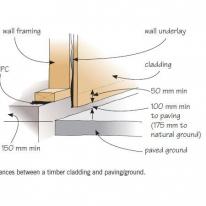Stained or clear-finished timber weatherboards too close to ground
Stained or clear-finished timber weatherboards too close to or in ground contact
Causes
Cause
Gardens have been built up
Repair
-
lower the soil/mulch level so it is clear of the cladding – the bottom of the cladding must be able to dry completely. Leave a minimum 30–50 mm gap between the base of the timber and the ground to prevent moisture uptake. With suspended timber floors, ensure that lowering the garden level does not lead to rainwater flowing under the house
-
check for rot in the bottom weatherboards with a screwdriver. Try to push it into the timber – if the screwdriver easily enters the timber, then the timber is rotten
-
if rot is found, replace all damaged or suspect weatherboards
-
where timber is sound, allow it to dry out completely. Scrape off loose coating and sand the bare timber until the surface is sound, then recoat
-
for suspended timber floors, ensure good subfloor ventilation:
-
there should be not less than 3500 mm² of clear open subfloor venting for every 1 m² of floor area
-
ventilation openings should ideally be high in the subfloor space, near to the underside of bearers
-
vents should be spread evenly around the building perimeter to allow cross-ventilation
-
no part of the subfloor should be more than 7.5 m from a ventilation opening.
Cause
Path or paving was laid against the cladding
Repair
-
where possible, break up and remove concrete or paving. Reform the ground surface so there is a minimum 30–50 mm gap between the base of the timber and the ground or new paving. With suspended timber floors, ensure that rainwater will flow away from the building
-
check for rot in the bottom weatherboards with a screwdriver. Try to push it into the timber – if the screwdriver easily enters the timber, then the timber is rotten
-
if rot is found, replace all damaged or suspect weatherboards
-
where timber is sound, allow it to dry out completely. Scrape off loose coating, sand the bare timber until the surface is sound and recoat
-
for suspended timber floors, ensure good subfloor ventilation:
-
there should be not less than 3500 mm² of clear open subfloor venting for every 1 m² of floor area
-
ventilation openings should ideally be high in the subfloor space, near to the underside of bearers
-
vents should be spread evenly around the building perimeter to allow cross-ventilation
-
no part of the subfloor should be more than 7.5 m from a ventilation opening.
Cause
Installed too close to the ground
Repair
-
aim for a minimum 30–50 mm gap between the base of the timber and the ground to prevent moisture uptake. The easiest way to achieve this may be by lowering the soil or garden level so it is clear of the cladding – the bottom of the cladding must be able to dry completely. With suspended timber floors, ensure that lowering the garden level does not lead to rainwater flowing under the house
-
check for rot in the bottom weatherboards with a screwdriver. Try to push it into the timber – if the screwdriver easily enters the timber, then the timber is rotten
-
if rot is found, replace all damaged or suspect weatherboards
-
where timber is sound, allow it to dry out completely. Scrape off loose coating, sand the bare timber until the surface is sound and recoat
-
for suspended timber floors, ensure good subfloor ventilation:
-
there should be not less than 3500 mm² of clear open subfloor venting for every 1 m² of floor area
-
ventilation openings should ideally be high in the subfloor space, near to the underside of bearers
-
vents should be spread evenly around the building perimeter to allow cross-ventilation
-
no part of the subfloor should be more than 7.5 m from a ventilation opening.





